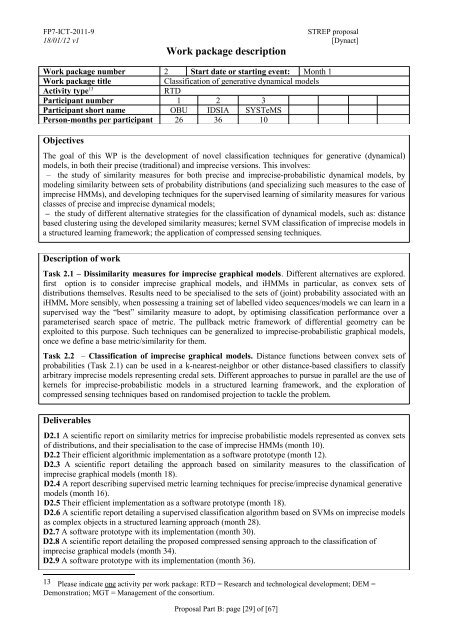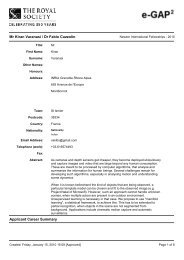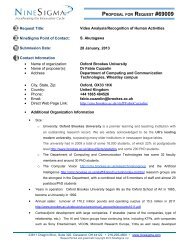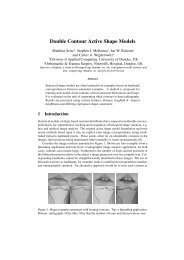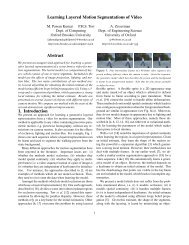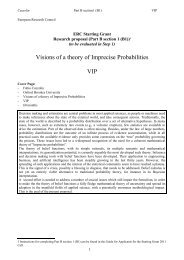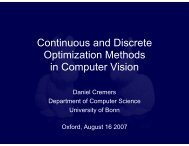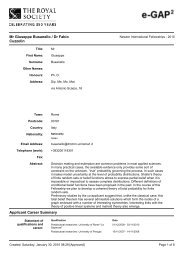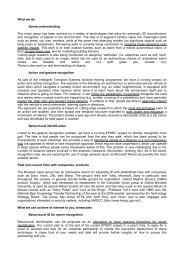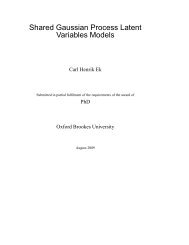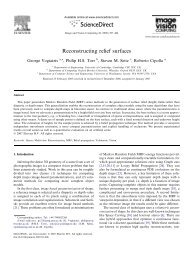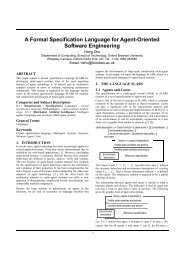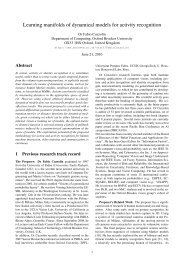Project Proposal (PDF) - Oxford Brookes University
Project Proposal (PDF) - Oxford Brookes University
Project Proposal (PDF) - Oxford Brookes University
Create successful ePaper yourself
Turn your PDF publications into a flip-book with our unique Google optimized e-Paper software.
FP7-ICT-2011-9 STREP proposal<br />
18/01/12 v1 [Dynact]<br />
Work package description<br />
Work package number 2 Start date or starting event: Month 1<br />
Work package title Classification of generative dynamical models<br />
Activity type 13 RTD<br />
Participant number 1 2 3<br />
Participant short name OBU IDSIA SYSTeMS<br />
Person-months per participant 26 36 10<br />
Objectives<br />
The goal of this WP is the development of novel classification techniques for generative (dynamical)<br />
models, in both their precise (traditional) and imprecise versions. This involves:<br />
– the study of similarity measures for both precise and imprecise-probabilistic dynamical models, by<br />
modeling similarity between sets of probability distributions (and specializing such measures to the case of<br />
imprecise HMMs), and developing techniques for the supervised learning of similarity measures for various<br />
classes of precise and imprecise dynamical models;<br />
– the study of different alternative strategies for the classification of dynamical models, such as: distance<br />
based clustering using the developed similarity measures; kernel SVM classification of imprecise models in<br />
a structured learning framework; the application of compressed sensing techniques.<br />
Description of work<br />
Task 2.1 – Dissimilarity measures for imprecise graphical models. Different alternatives are explored.<br />
first option is to consider imprecise graphical models, and iHMMs in particular, as convex sets of<br />
distributions themselves. Results need to be specialised to the sets of (joint) probability associated with an<br />
iHMM. More sensibly, when possessing a training set of labelled video sequences/models we can learn in a<br />
supervised way the “best” similarity measure to adopt, by optimising classification performance over a<br />
parameterised search space of metric. The pullback metric framework of differential geometry can be<br />
exploited to this purpose. Such techniques can be generalized to imprecise-probabilistic graphical models,<br />
once we define a base metric/similarity for them.<br />
Task 2.2 – Classification of imprecise graphical models. Distance functions between convex sets of<br />
probabilities (Task 2.1) can be used in a k-nearest-neighbor or other distance-based classifiers to classify<br />
arbitrary imprecise models representing credal sets. Different approaches to pursue in parallel are the use of<br />
kernels for imprecise-probabilistic models in a structured learning framework, and the exploration of<br />
compressed sensing techniques based on randomised projection to tackle the problem.<br />
Deliverables<br />
D2.1 A scientific report on similarity metrics for imprecise probabilistic models represented as convex sets<br />
of distributions, and their specialisation to the case of imprecise HMMs (month 10).<br />
D2.2 Their efficient algorithmic implementation as a software prototype (month 12).<br />
D2.3 A scientific report detailing the approach based on similarity measures to the classification of<br />
imprecise graphical models (month 18).<br />
D2.4 A report describing supervised metric learning techniques for precise/imprecise dynamical generative<br />
models (month 16).<br />
D2.5 Their efficient implementation as a software prototype (month 18).<br />
D2.6 A scientific report detailing a supervised classification algorithm based on SVMs on imprecise models<br />
as complex objects in a structured learning approach (month 28).<br />
D2.7 A software prototype with its implementation (month 30).<br />
D2.8 A scientific report detailing the proposed compressed sensing approach to the classification of<br />
imprecise graphical models (month 34).<br />
D2.9 A software prototype with its implementation (month 36).<br />
13 Please indicate one activity per work package: RTD = Research and technological development; DEM =<br />
Demonstration; MGT = Management of the consortium.<br />
<strong>Proposal</strong> Part B: page [29] of [67]


